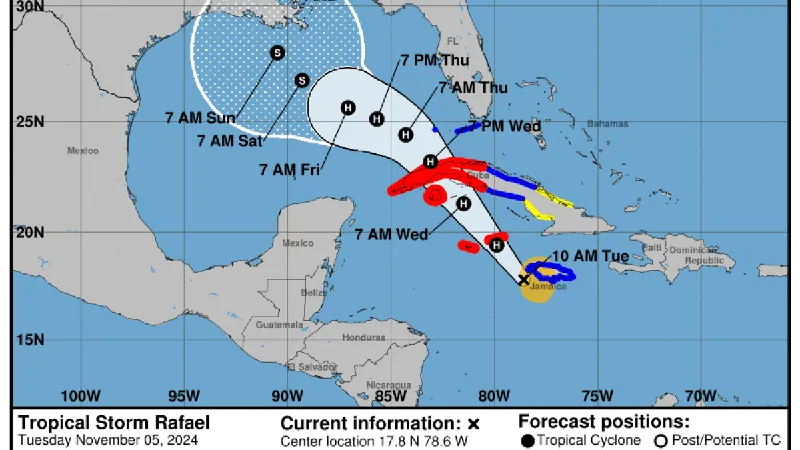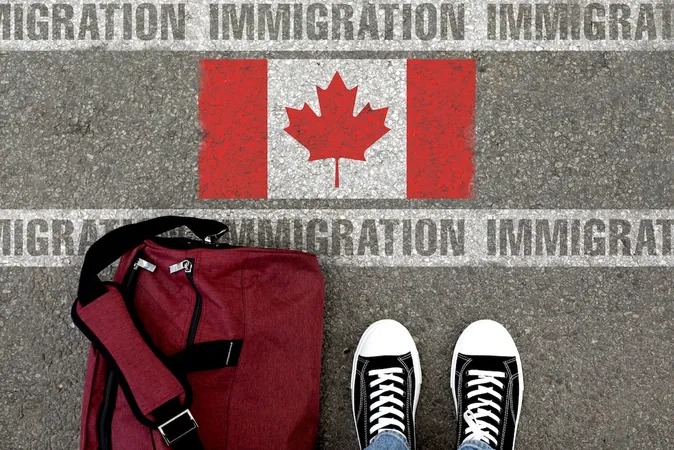
Tropical Storm Rafael Set to Intensify into Hurricane Before Impacting Cuba
2024-11-05
Author: Michael
Tropical Storm Rafael Overview
Tropical Storm Rafael is poised to strengthen into a hurricane in the northwestern Caribbean, with predictions highlighting a significant intensification as it approaches Cuba. According to the United States National Weather Service, Rafael was situated approximately 115 kilometers (70 miles) southwest of Montego Bay, Jamaica, on Tuesday afternoon, exhibiting maximum sustained winds of 95 km/h (60 mph) and moving northwest at a speed of 23 km/h (14 mph).
Anticipated Path and Impact
As the storm travels west of Jamaica, it is expected to be near or over the Cayman Islands by the evening, ultimately making landfall in western Cuba as a Category 1 hurricane, with projected sustained winds reaching 145 km/h (90 mph) by Wednesday.
After traversing Cuba, forecasts suggest Rafael will curve northwest toward the Gulf of Mexico, where it is likely to encounter unfavorable upper atmosphere conditions, which could hinder its development further.
Heavy Rainfall and Flooding Concerns
The National Hurricane Center (NHC) indicated that despite this trajectory, the storm is still expected to unleash heavy rainfall across the western Caribbean, with potential local totals of up to 250 mm (10 inches) in some areas of Jamaica and Cuba, raising concerns about flooding and mudslides.
Impact on Cuba's Energy Crisis
The impending storm threatens to exacerbate an ongoing energy crisis in Cuba. Many parts of the island have faced significant power outages recently, a consequence of deteriorating infrastructure and a shortage of fuel for power generation. This situation has been compounded by the recent devastation wrought by Hurricane Oscar, which struck the eastern region of Cuba two weeks ago, resulting in at least six fatalities.
Preparations and Warnings
In anticipation of Rafael's arrival, hurricane warnings are currently in effect for the Cayman Islands and western Cuba, including Havana and the tobacco-rich province of Pinar del Rio. A tropical storm warning has been issued for Jamaica, central Cuba, and portions of the Florida Keys. Authorities across these regions are urging residents to remain vigilant, highlighting the importance of preparedness as the storm approaches.
Officials in the Cayman Islands have proactively closed schools and government offices, with residents forming long lines at grocery stores to stock up on supplies. Jamaica also took precautionary measures, experiencing the storm's outer winds late Monday, prompting officials to encourage vigilance among citizens.
Cuban authorities have issued evacuation orders, affecting approximately 37,000 residents in the eastern province of Guantanamo.
Storm Season Insights
Rafael is noted as the 17th named storm of the Atlantic hurricane season. Meteorological definitions classify a tropical storm as having sustained winds between 63 km/h (39 mph) and becoming a hurricane once these winds reach 119 km/h (74 mph).
Looking Ahead: Future Hurricane Forecasts
Looking ahead, the National Oceanic and Atmospheric Administration (NOAA) has projected that the 2024 hurricane season could be significantly active, with forecasts for 17 to 25 named storms, including as many as 13 hurricanes and four major hurricanes. Such predictions paint a picture of an increasingly volatile hurricane season, which runs from June 1 to November 30, although storm occurrences typically diminish in the final month as cooler temperatures set in.
Conclusion
As Tropical Storm Rafael bears down on the Caribbean, residents are urged to stay informed and prepared for what could be a challenging weather event. The repercussions of this storm may not only shape the immediate future for the affected regions but also underscore the ongoing challenges they face in terms of infrastructure and disaster preparedness.









 Brasil (PT)
Brasil (PT)
 Canada (EN)
Canada (EN)
 Chile (ES)
Chile (ES)
 España (ES)
España (ES)
 France (FR)
France (FR)
 Hong Kong (EN)
Hong Kong (EN)
 Italia (IT)
Italia (IT)
 日本 (JA)
日本 (JA)
 Magyarország (HU)
Magyarország (HU)
 Norge (NO)
Norge (NO)
 Polska (PL)
Polska (PL)
 Schweiz (DE)
Schweiz (DE)
 Singapore (EN)
Singapore (EN)
 Sverige (SV)
Sverige (SV)
 Suomi (FI)
Suomi (FI)
 Türkiye (TR)
Türkiye (TR)